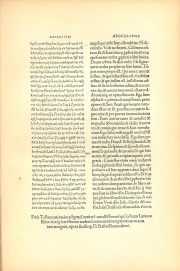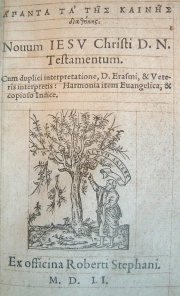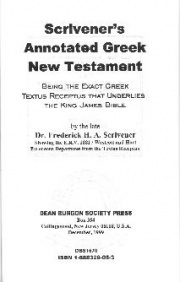Textus Receptus
From Textus Receptus
Textus Receptus (Latin: "received text") is the name subsequently given to the succession of printed Greek texts of the New Testament which constituted the translation base for the original German Luther Bible, for the translation of the New Testament into English by William Tyndale, the King James Version, and for most other Reformation-era New Testament translations throughout Western and Central Europe. The series originated with the first printed Greek New Testament to be published; a work undertaken in Basel by the Dutch Catholic scholar and humanist Desiderius Erasmus in 1516, on the basis of some six manuscripts, containing between them not quite the whole of the New Testament. Although based mainly on late manuscripts of the Byzantine text-type, Erasmus's edition differed markedly from the classic form of that text.
Contents[hide] |
History of the Textus Receptus
See Also Novum Instrumentum omne The Dutch humanist Erasmus had been working for years on two projects: a collation of Greek texts and a fresh Latin New Testament. In 1512, he began his work on a fresh Latin New Testament. He collected all the Vulgate manuscripts he could find to create a critical edition. Then he polished the Latin. He declared, "It is only fair that Paul should address the Romans in somewhat better Latin."<ref>"Epistle 695" in Collected Works of Erasmus Vol. 5: Letters 594 to 841, 1517-1518 (tr. R.A.B. Mynors and D.F.S. Thomson; annotated by James K. McConica; Toronto: University of Toronto Press, 1976), 172.</ref> In the earlier phases of the project, he never mentioned a Greek text: "My mind is so excited at the thought of emending Jerome’s text, with notes, that I seem to myself inspired by some god. I have already almost finished emending him by collating a large number of ancient manuscripts, and this I am doing at enormous personal expense."<ref>"Epistle 273" in Collected Works of Erasmus Vol. 2: Letters 142 to 297, 1501-1514 (tr. R.A.B. Mynors and D.F.S. Thomson; annotated Wallace K. Ferguson; Toronto: University of Toronto Press, 1976), 253.</ref>
While his intentions for publishing a fresh Latin translation are clear, it is less clear why he included the Greek text. Though some speculate that he intended on producing a critical Greek text or that he wanted to beat the Complutensian Polyglot into print, there is no evidence to support this. Rather his motivations seems to be simpler: he included the Greek text to prove the superiority of his Latin version. He wrote, "There remains the New Testament translated by me, with the Greek facing, and notes on it by me."<ref>"Epistle 305" in Collected Works of Erasmus. Vol. 3: Letters 298 to 445, 1514-1516 (tr. R.A.B. Mynors and D.F.S. Thomson; annotated by James K. McConica; Toronto: University of Toronto Press, 1976), 32.</ref> He further demonstrated the reason for the inclusion of the Greek text when defending his work: "But one thing the facts cry out, and it can be clear, as they say, even to a blind man, that often through the translator’s clumsiness or inattention the Greek has been wrongly rendered; often the true and genuine reading has been corrupted by ignorant scribes, which we see happen every day, or altered by scribes who are half-taught and half-asleep."<ref>"Epistle 337" in Collected Works of Erasmus Vol. 3, 134.</ref> Erasmus's new work was published by Froben of Basel in 1516 and thence became the first published Greek New Testament, the Novum Instrumentum omne, diligenter ab Erasmo Rot. Recognitum et Emendatum. He used manuscripts: 1, 1rK, 2e, 2ap, 4ap, 7, 817.<ref>W.W. Combs, Erasmus and the textus receptus, DBSJ 1 (Spring 1996), 45. </ref> The second edition used the more familiar term Testamentum instead of Instrumentum, and eventually became a major source for Luther's German translation. In second edition (1519) Erasmus used also Minuscule 3.
Typographical errors (attributed to the rush to complete the work) abounded in the published text. Erasmus also lacked a complete copy of the book of Revelation and was forced to translate the last six verses back into Greek from the Latin Vulgate in order to finish his edition. Erasmus adjusted the text in many places to correspond with readings found in the Vulgate, or as quoted in the Church Fathers; and consequently, although the Textus Receptus is classified by scholars as a late Byzantine text, it differs in nearly two thousand readings from standard form of that text-type; as represented by the "Majority Text" of Hodges and Farstad (Wallace 1989). The edition was a sell-out commercial success; and was reprinted in 1519, with most—though not all—the typographical errors corrected.<ref>Bruce M. Metzger, B. D. Ehrman, The Text of the New Testament: Its Transmission, Corruption and Restoration, Oxford University Press, 2005, p. 145. </ref>
Erasmus had been studying Greek New Testament manuscripts for many years, in the Netherlands, France, England and Switzerland, noting their many variants; but he only had six Greek manuscripts immediately accessible to him in Basel.<ref>W.W. Combs, Erasmus and the textus receptus, DBSJ 1 (Spring 1996), 45. </ref> They all dated from the 12th Century or later, and only one came from outside the mainstream Byzantine tradition. Consequently, most modern scholars consider his text to be of dubious quality.<ref name="dubious">Bruce Metzger, The Text of the New Testament, p. 99.</ref>
With the third edition of Erasmus' Greek text (1522) the Comma Johanneum was included, because a single 16th-century Greek manuscript (Codex Montfortianus) had subsequently been found to contain it, though Erasmus had expressed doubt as to the authenticity of the passage in his Annotations. Popular demand for Greek New Testaments led to a flurry of further authorized and unauthorized editions in the early sixteenth century; almost all of which were based on Erasmus's work and incorporated his particular readings, although typically also making a number of minor changes of their own.
The overwhelming success of Erasmus' Greek New Testament completely overshadowed the Latin text upon which he had focused. Many other publishers produced their own versions of the Greek New Testament over the next several centuries. Rather than doing their own critical work, most just relied on the well-known Erasmian text.
See Also Editio Regia
Robert Estienne, known as Stefanus (1503-1559), a printer from Paris, edited four times the Greek New Testament, 1546, 1549, 1550, and 1551, the last in Geneva. The first two are among the neatest Greek texts known, and are called O mirificam; the third edition is a splendid masterpiece of typographical skill. It has critical apparatus in which quoted manuscripts referred to the text. Manuscripts were marked by symbols (from α to ις). He used Polyglotta Complutensis (symbolized by α) and 15 Greek manuscripts. In this number manuscripts: Codex Bezae, Codex Regius, minuscules 4, 5, 6, 2817, 8, 9. The first step towards to modern Textual Criticism was made. The third edition is known as the Editio Regia; the edition of 1551 contains the Latin translation of Erasmus and the Vulgate, is not nearly as fine as the other three, and is exceedingly rare. It was in this edition that the division of the New Testament into verses was for the first time introduced.
The third edition of Estienne was used by Theodore Beza (1519-1605), who edited it nine times between 1565 and 1604. In the critical apparatus of the second edition he used the Codex Claromontanus and the Syriac New Testament published by Emmanuel Tremellius in 1569. Codex Bezae was twice referenced (as Codex Bezae and β' of Estienne).
The origin of the term "Textus Receptus" comes from the publisher's preface to the 1633 edition produced by Bonaventure and Abraham Elzevir, two brothers and printers at Leiden: textum ergo habes, nunc ab omnibus receptum, in quo nihil immulatum aut corruptum damus, translated "so you hold the text, now received by all, in which nothing corrupt." The two words, textum and receptum, were modified from the accusative to the nominative case to render textus receptus. Over time, this term has been retroactively applied to Erasmus' editions, as his work served as the basis of the others.<ref>Bruce M. Metzger, Bart D. Ehrman, "The Text Of The New Testament: Its Transmission, Corruption and Restoration", Oxford University Press, 2005, p. 152. </ref>
Textual criticism and the Textus Receptus
John Mill (1645-1707), collated textual variants from 82 Greek manuscripts. In his Novum Testamentum Graecum, cum lectionibus variantibus MSS (Oxford 1707) he reprinted the unchanged text of the Editio Regia, but in the index he enumerated 30,000 textual variants.<ref>T. Robertson, An Introduction to the Textual Criticism of the New Testament, Nashville: Broadman, 1925, pp. 107-108. </ref>
Shortly after Mill published his edition, Daniel Whitby (1638-1725), attacked his work. He claimed that the autographs of the New Testament were identical to the Textus Receptus, and that the text had never been corrupted. He believed the text of the Holy Scripture was endangered by the 30,000 variants in Mill's edition. Whitby claimed that every part of the New Testament should be defended against these variants.<ref>D. Whitby, Examen variantium Lectionum Johannis Milli, London 1709. </ref>
Johann Albrecht Bengel (1687-1752), in 1725 edited Prodromus Novi Testamenti Graeci Rectè Cautèque Adornandi, in 1734 edited Novum Testamentum Graecum. Bengel divided manuscripts into families and subfamilies. He favoured (lectio difficilior potior).
Johann Jakob Wettstein. His Apparatus was fuller than of any previous editor. He introduced the practice of indicating the ancient manuscripts by capital Roman letters and the later manuscripts by Arabic numerals. He published in Basel Prolegomena ad Novi Testamenti Graeci (1731).
J. J. Griesbach (1745-1812) combined the principles of Bengel and Wettstein. He enlarged the Apparatus by a more citations from the Fathers, and various versions, such as the Gothic, the Armenian, and the Philoxenian. Griesbach distinguished a Western, an Alexandrian, and a Byzantine Recension.<ref>J. J. Griesbach, Novum Testamentum Graece, (London 1809) </ref> Christian Frederick Matthaei (1744-1811) was a Griesbach opponent.
Karl Lachmann (1793-1851), was the first who broke with the Textus Receptus. His object was to restore the text to the form in which it had been read in the ancient Church about A.D. 380. He used the oldest known Greek and Latin manuscripts.
Westcott and Hort, The New Testament in the Original Greek (1881).
The majority of textual critical scholars since the late 19th Century, have adopted an eclectic approach to the Greek New Testament; with the most weight given to the earliest extant manuscripts which tend mainly to be Alexandrian in character; the resulting eclectic Greek text departing from the Textus Receptus in around 6,000 readings. A significant minority of textual scholars, however, maintain the priority of the Byzantine text-type; and consequently prefer the "Majority Text". No school of textual scholarship now continues to defend the priority of the Textus Receptus; although this position does still find adherents amongst the King-James-Only Movement, and other Protestant groups hostile to the whole discipline of text criticism—as applied to scripture; and suspicious of any departure from Reformation traditions.
Defense of the Textus Receptus
Frederick von Nolan, a 19th century historian and Greek and Latin scholar, spent 28 years attempting to trace the Textus Receptus to apostolic origins. He was an ardent advocate of the supremacy of the Textus Receptus over all other editions of the Greek New Testament, and argued that the first editors of the printed Greek New Testament intentionally selected the texts they did because of their superiority and disregarded other texts which represented other text-types because of their inferiority.
- It is not to be conceived that the original editors of the [Greek] New Testament were wholly destitute of plan in selecting those manuscripts, out of which they were to form the text of their printed editions. In the sequel it will appear, that they were not altogether ignorant of two classes of manuscripts; one of which contains the text which we have adopted from them; and the other that text which has been adopted by M. Griesbach.<ref name="text-types">An Inquiry into the Integrity of the Greek Vulgate, or Received Text of the New Testament; in which the Greek Manuscripts are newly classed; the Integrity of the Authorised Text vindicated; and the Various Readings traced to their Origin (London, 1815), ch. 1. The sequel mentioned in the text is Nolan's Supplement to an Inquiry into the Integrity of the Greek Vulgate, or Received Text of the New Testament; containing the Vindication of the Principles employed in its Defence (London, 1830).</ref>
Regarding Erasmus, Nolan stated:
Nor let it be conceived in disparagement of the great undertaking of Erasmus, that he was merely fortuitously right. Had he barely undertaken to perpetuate the tradition on which he received the sacred text he would have done as much as could be required of him, and more than sufficient to put to shame the puny efforts of those who have vainly labored to improve upon his design. [...] With respect to Manuscripts, it is indisputable that he was acquainted with every variety which is known to us, having distributed them into two principal classes, one of which corresponds with the Complutensian edition, the other with the Vatican manuscript. And he has specified the positive grounds on which he received the one and rejected the other.<ref name="varieties">ibid., ch. 5</ref>
Regarding 1 John 5:7, the long-standing belief that MS. 61 was created specifically to force Erasmus to add the text is no longer considered a legitimate concern. Metzger himself admits this in the 3rd edition of The Text of the New Testament... when he notes (footnote 2 on p. 292):
What was said about Erasmus promise and his subsequent suspicion that MS. 61 was written expressly to force him to [add 1 John 5:7 to the text], needs to be corrected in light of the research of H.J. de Jonge, a specialist in Erasmian studies who finds no explicit evidence that supports this frequently made assertion.
Textus Receptus was defended by Burgon in his The Revision Revised (1881), by Edward Miller in A Guide to the Textual Criticism of the New Testament. According to Burgon Codex Alexandrinus, and Codex Ephraemi are older than Sinaiticus, and Vaticanus. Peshitta originated from the 2nd century. Arguments of Miller were of the same kind, but two of the agreed that Textus Receptus needs correction. Hills took different point of view. Hills rejected text of majority (Byzantine text) and according to him Textus Receptus was the closest text to the autographs. He concluded that Erasmus was divinely guided when he introduced Latin Vulgate readings into his Greek text.<ref>Edward F. Hills, King James Version Defended!, pp. 199-200. </ref> He even argued for the authenticity of the Comma Johanneum.<ref>Edward F. Hills, King James Version Defended!, pp. 209-213. </ref>
Relationship to the Byzantine text
Textus Receptus was established on a basis of the Byzantine text-type, called also 'Majority text', and usually is identified with him by his followers. But Textus Receptus has some additions and variants which did not exist in the Byzantine text before the 16th century. The Comma Johanneum in 1 John 5:7 is well known example, but there are also other texts like: Matthew 10:8; 27:35; Luke 17:36; John 3:25; Acts 8:37; 9:5; 15:34; and some readings ("book of life" instead of "tree of life" in Revelation 22:19) which the Byzantine text did not have. In these cases the majority of manuscripts agree with the Alexandrian text-type against the Textus Receptus.
F. H. A. Scrivener (1813-1891) remarked that Matt. 22:28, 23:25, 27:52, 28:3, 4, 19, 20; Mark 7:18, 19, 26, 10:1, 12:22, 15:46; Luke 1:16, 61, 2:43, 9:1, 15, 11:49; John 1:28, 10:8, 13:20 are under the influence of Minuscule 1 (Caesarean text-type).<ref name = Scrivener183>F. H. A. Scrivener, A Plain Introduction to the Criticism of the New Testament, London 1894, vol. 2, pp. 183-184. </ref> Scrivener showed that some texts were incorporated from the Vulgate (for example, Acts 9:6; Rev 17:4.8). Daniel Wallace enumerated that in 1,838 places (1005 are translatable) Textus Receptus differs from the Byzantine text-type.<ref>Daniel Wallace, "Some Second Thoughts on the Majority Text", Bibliotheca Sacra, July-September, 1989, p. 276. </ref>
Dean Burgon, one of the main supporter of the Textus Receptus declares that the Textus Receptus needs correction.<ref>Burgon, The Revised Revision, p. 548. </ref> He suggested 150 corrections in the Textus Receptus Gospel of Matthew alone.<ref>Burgon, Revised Revision, p. 242. </ref>
- Matthew 10:8 it has Alexandrian reading νεκρους εγειρετε (raise the dead) omitted by the Byzantine text.<ref>NA26, p. 24. Burgon, The Revised Revision, p. 108; Edward Miller, Textual Commentary Upon the Holy Gospels, p. 75. </ref>
- Acts 20:28 it has Alexandrian reading του Θεου (of the God) instead of Byzantine του κυριου και του Θεου (of the Lord and God).
See also
- Other text-types
- Other articles
Notes
Further reading
- S. P. Tregelles, The Printed Text of the Greek New Testament, London 1854.
- Bruce M. Metzger, B. D. Ehrman, The Text of the New Testament: Its Transmission, Corruption and Restoration, Oxford University Press, 2005.
- W. W. Combs, Erasmus and the textus receptus, DBSJ 1 (Spring 1996).
- Daniel B. Wallace, Some Second Thoughts on the Majority Text. Bibliotheca Sacra 146 (1989): 270-290.
- Dr James White. King James Only Controversy, Can You Trust the Modern Translations? Bethany House, 1995.
External links
- Modern Textual Criticism
- The Textus Receptus at the Encyclopedia of Textual Criticism
- W.W. Combs, Erasmus and the textus receptus, DBSJ 1 (Spring 1996): 35-53.
- H. J. de Jonge, Daniel Heinsius and the Textus Receptus of the New Testament
- M. Arhelger, Die Textgrundlage des Neues Testaments, 2006 Template:De icon
- Westcott & Hort vs. Textus Receptus from Bible Research
- The Majority Text Compared to the Received Text Bible Research
- Comparison of the Textus Receptus with other manuscript editions on the Manuscript Comparator
- Defense of Textus Receptus



